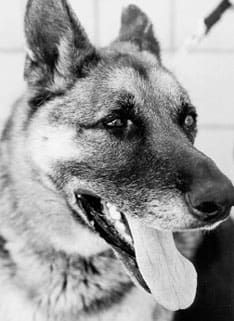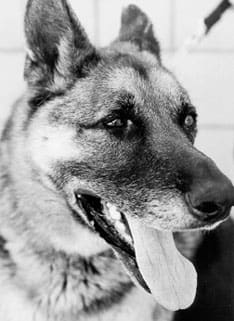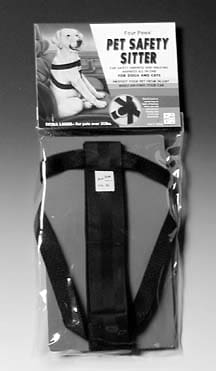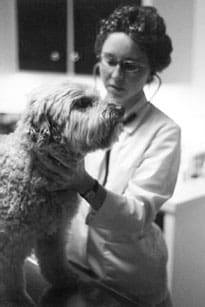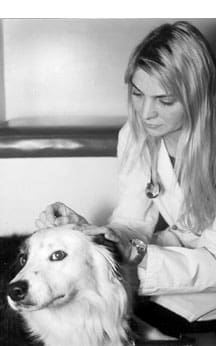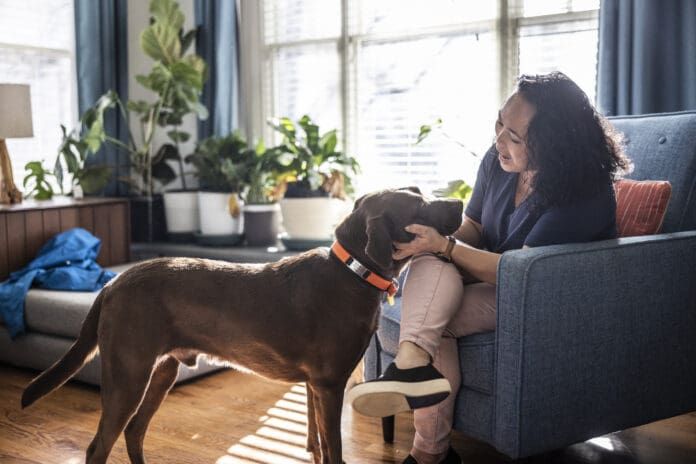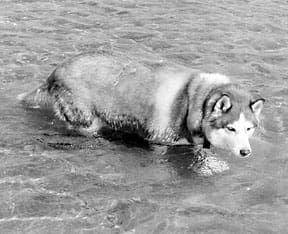[Updated December 18, 2018]
At some time or another, every dog lover has endured a blast of bad breath from an ardent canine companion. Foul-smelling breath is so prevalent among pooches that the very phrase has come to be an insult, as in, “Get lost, dog breath!”
Even so, a mention of the idea of preventative dental hygiene for dogs strikes some people as weird, if not nearly ridiculous. “Toothbrushes for dogs? You’ve got to be kidding!”

But it’s no joke. Chew on these findings: a 1995 University of Minnesota epidemiology study of 67,000 dogs and cats showed oral disease to be the most common canine and feline clinical disease. And a 1996 Kansas State University study showed periodontal disease to be associated with chronic internal organ diseases of the heart, kidneys, and liver.
Our own dog husbandry practices are to blame for most of the factors that contribute to the poor condition of our dogs’ choppers – including the diets that we provide for our dogs and human-engineered breeding programs.
Fortunately, this means that dog owners also have the power to reverse this unhealthy trend: You can observe their teeth for early signs of trouble, enabling you to treat small problems before they worsen; you can give them nutritional support for healthy teeth and gums; and you can help keep their teeth clean. By implementing a thoughtful plan for dental health, you can help ensure your dog’s teeth will contribute to his longevity and zest for life, not to mention, help make his doggie “kisses” fresher!
A Dog’s Clean Teeth Contribute to Overall Health
The focus of all dental care is the removal of plaque, which is composed of a mixture of oral bacteria, bacterial sugars, salivary proteins, and food and cellular debris, and dental calculus, or tartar, which is comprised of a mixture of mineralized concretions of salivary calcium and phosphate salts, and plaque. The presence of plaque on the teeth can cause gum inflammation or “gingivitis,” visible as a reddening of the tissue along the gum line. (Tartar does not directly cause gingivitis; rather, the calculus serves as a spot for plaque to collect and for bacteria to multiply.)
With dogs, “cavities” in the teeth are rare; it’s gingivitis that wreaks havoc with the dog’s health. Initially, it’s the pain of gingivitis that diminishes the dog’s quality of life; not only do dogs use their mouths for eating or drinking, but also for grooming, social interaction, and playing with toys. If a dog is reluctant to use his mouth for any of these activities, his gum problems can worsen due to reduced circulation.
If the gingivitis advances to a full-blown infection, it can make the dog very sick. “One single infected root can make a dog – or a person, for that matter – seriously ill,” warns Dr. Nancy Scanlan, a veterinarian with a holistic practice in Sherman Oaks, California. “And oral infection can constantly enter your bloodstream and cause trouble elsewhere in the body. It can wreak havoc with the joints, lungs, kidneys, liver . . . you can get into multiple body problems from one little tooth.” Learn the signs and symptoms of infected teeth in dogs here.
Dogs’ Teeth are a Man-Made Problem
As mentioned above, dog owners are responsible for many of the factors that contribute to the poor condition of their dogs’ bad teeth. No one is likely to verify this first-hand, but wild canines like wolves and coyotes are unlikely to share domesticated dogs’ dental problems, in large part because our dogs don’t use their teeth in the same way as their wild brethren. The sharp front teeth of dogs are designed for cutting through tissue and tearing raw meat; the powerful jaws and sturdy back teeth are best used for gnawing on and crushing bones. Wild canines who engage in these activities daily generally have strong teeth that are scraped clean, with healthy gums.
But the efficient design of the dog’s teeth is wasted on our domestic pets, who usually eat kibble or canned food. Dog teeth were never intended to chew foods like these. (Ironically, it’s humans, who manufacture and provide this food for our dogs, who have teeth that are ideally suited for chew nuggets of dry dog food – grinding teeth with flattened tops.) Canned and soft food are even worse for dogs’ teeth; they lack even the minimal abrasive action provided by dry food, and are more likely to contain sugars that contribute to dental disease. I’d bet a buck that the insulting phrase “dog breath” originated in the 1950s, when the commercial dog food industry was born and feeding commercially-prepared food to dogs became de riguer.
Humans have also expedited their dogs’ dental problems through hundreds of generations of breeding to create a tremendous variety in the shape and size of dogs, especially in the canine head. Unique characteristics have been refined in different breeds over time; still, most dogs have 42 permanent teeth, regardless of size or shape of the jaw. In many breeds, this has resulted in crowding of teeth, which can lead to increased retention of plaque, gingivitis (inflammation of the gums), and eventually, to loss of teeth and infection. Today, tooth extractions are routine in a multitude of breeds; without extractions, many dogs would be unable to survive the crowded, dysfunctional mouths they have inherited.
Taking Teeth Cleaning into Your Own Hands
While occasional professional cleaning is important, according to Dr. Eisner, toothbrushing is the best way to remove plaque from the dog’s teeth.
Any soft-bristled toothbrush may be used; it doesn’t have to be a special brush for dogs, although several manufacturers have innovated brushes that can make the task marginally easier.
Nylabone, for instance, makes a handy two-sided brush that allows you to scrub both sides of a tooth at the same time. The bristles of Crazy Dog’s “Easy Grip PetAdent” are arranged in a semicircle, for the same purpose. The PetAdent’s bristles are black, reportedly because they are easier to see against white teeth. Several manufacturers also make rubber or plastic “fingertip” brushes that you slip on like finger of a glove; they have bristles affixed to the tip. Four Paws Products makes a longhandled brush with a large head at one end and a small head at the other – great for long-nosed dogs and big dogs. These novelties are useful, but not necessary.
However, there is one toothbrushing product on the market that Dr. Eisner is vigorously opposed to: the Plaque Whacker. The cleaning brush on this device resembles the scrubbing material that kitchen sponges are sometimes backed with, only it’s much stiffer. This device is brutal against delicate oral tissues and the thin enamel of dogs’ teeth. It can also cause microscopic etch marks on the teeth, creating sites for plaque adhesion.
The Value of Toothpaste
Toothpaste is not necessary to get the dog’s teeth clean, though it can make the project easier. Don’t use the stuff from your family’s medicine cabinet, however. Special meat- or peanut butter-flavored toothpastes for dogs have two advantages: they are far more attractive to dogs than minty “people” toothpastes, and they contain substances that are better suited to killing the bacteria found in dog mouths.
Toothpastes can work two ways: mechanically and chemically. Some contain inert abrasive materials such as calcium or silicate, which take a significant mechanical role in helping scrub plaque and other matter from the teeth and gums. But even those pastes without abrasives can play a mechanical role, by lubricating the bristles of a toothbrush for better action.
Toothpastes can also work chemically. Today, a variety of substances are employed to kill the bacteria that lends itself to plaque formation. Two such substances are chlorhexidine and hypothiocyanate. The former kills the aerobic (oxygen-dependent)
bacteria commonly found in a healthy dog mouth. The latter is aimed at killing the pathogenic (illness-causing) anaerobic bacteria that multiply in and “infect” periodontal pockets in an unhealthy dog mouth. Which type of product you use should depend on the condition of your dog’s periodontal area (the gum/tooth margin). If the dog has tight, pink gums and teeth with little tartar, the chlorhexidine products are more appropriate. The hypothiocyanate products are helpful when the dog is known to have periodontal problems.
Delivering the Goods
All of these substances are available in several delivery systems: toothpastes (which are generally scrubbed onto the teeth and gums), gels (topically applied to the gums), liquid rinses (which are squirted into the mouth), rawhide chews that have been impregnated with the substances, and small cloth pads (which are wiped onto the teeth and gums). In Eisner’s estimation, the most effective are the toothpastes and the rawhide chews, because of the abrasive action they provide; the least helpful are the pads.
“If you think about your own teethcleaning experiences, it’s easy to judge these different forms,” he says. “The goal is to apply the dentifrice to as many surfaces of the teeth and gums as possible. One benefit of the liquids is that they readily wash into crevices and crannies in the dog’s teeth and gums. But a shortcoming is that they provide no abrasive or scrubbing action; imagine only using mouthwash, and never brushing your teeth.”
Eisner finds the teeth-cleaning pads to be the least useful delivery system, since they can neither deliver the dentifrices to every surface of the dog’s teeth or gums, nor scrub the teeth very efficiently.
Teeth Cleaning Controversies
Everyone agrees that dogs’ teeth should be clean. But as soon as we begin to talk about ways to remove plaque from our dogs’ teeth, arguments ensue. The people who maintain that by feeding our dogs a diet that is as close to that of wild canines as possible (consisting largely of raw meat and bones), contend that dogs should be able to maintain clean teeth all on their own. Others say that feeding raw meat and bones is time-consuming, expensive, and potentially dangerous to the dog. Dogs can die from ingesting bacteria in raw meat and slivers from bones, they argue, and they are more than happy to brush their dogs’ teeth, if that’s what is necessary to keep their dogs “safe” from the pitfalls of the meat and bones diet.
One truth that stands above the fray is that you don’t have to stand by helplessly while sinister events are taking place in your dog’s mouth. Obviously, there are advantages and disadvantages to every dental health approach. As always, you will have to choose the options that make the most sense for you and your dog.
Regular Doggy Dental Exams
That said, be aware that most veterinarians maintain that the first part of a good dental health program is professional evaluation. An oral exam should be an integral part of every veterinary checkup, starting from a puppy’s earliest health examination. Your veterinarian will check your puppy’s bite to make sure the teeth mesh well, and to monitor the loosening of her deciduous (or “baby”) teeth and the eruption of her permanent teeth.
Normally, in the process of shedding the deciduous teeth, the roots dissolve and the newly unmoored teeth fall out, in order to make way for the permanent teeth. When these baby teeth are said to be “retained,” it’s because the roots have failed to dissolve normally. If a tooth is erupting awry, or the deciduous teeth are retained, your veterinarian will be able to judge whether or not to intercede with an extraction, or whether some method of orthodontia should be used to bring errant teeth to the appropriate place.
As your dog ages, your veterinarian will also be able to monitor the condition of any teeth your dog may have broken or worn down to the nub. These conditions don’t always require treatment, but they must be observed for signs of infection or other problems with the roots.
Professional Cleaning Teeth Cleaning for Dogs
In addition to examinations, many veterinarians feel that dogs should have at least one annual prophylactic teeth cleaning to support all-around health – even though some dog owners have concerns about the anesthesia required for these procedures (see link to the right). In an effort to expose the dog to as few drugs as possible, as long as the examination showed that a dog’s teeth were clean and white, some veterinarians would sanction passing up the annual cleaning.
But given the number of serious health concerns that bad teeth can cause, other veterinarians make a case for a more aggressively preventative plan. According to Edward Eisner, DVM, Diplomate of the American Veterinary Dental College, “Ideally, a dog should have its teeth cleaned within the first 18 months of life. A perfect time to do this is while the dog is being anesthetized for spaying or neutering. Teeth cleaning visits should also include an educational session with the pet’s owner, to teach toothbrushing.”
During this initial educational visit, Eisner suggests that veterinarians gauge the owner’s interest in home dental care. The suggested interval between teeth-cleaning visits, he says, will depend on the condition of the dog’s mouth and the owner’s interest in or ability to maintain the dog’s clean teeth.
According to Dr. Eisner, a thorough cleaning will include ultrasonic scaling to remove plaque and calculus above and beneath the gumline, in addition to manual work with hand-held dental tools. Periodontal therapy, he describes, goes a step beyond routine cleaning, by scaling the root surfaces. Finally, polishing the tooth surface is accomplished with a tiny, vibrating rubber cup and abrasive dentifrice to discourage plaque adherence.
One of the reasons these thorough cleanings are necessary, says Eisner, is because dogs with periodontal disease may or may not exhibit problems. Their owners may report nonclinical signs of tooth problems, without recognizing them as such. These behaviors include poor self-grooming, incessant nose licking, hesitancy to open or close the mouth all the way, decreased chewing of toys or treats, pawing at the mouth, facial rubbing, head or mouth handling shyness, or a sudden preference for soft food. Other symptoms include bad breath, sneezing, and one-sided nasal discharge.
Owners of small dogs and older dogs need to devote more time and attention to their dogs’ teeth, says Eisner, because these dogs have a much higher incidence of periodontal disease than do large or young dogs. “In a situation of chronic inflammation, the bone will shrink away from the gums at a rate of 1.5 mm per year. An Akita tooth may have a root 30 mm thick, a Chihuahua only 5 mm thick. At the rate of 1.5 mm per year of bone loss, the Akita has time before there is a noticeable problem, but the Chihuahua has only a couple of years before radical therapy is needed,” Eisner says.
The “Dangers” of Anesthesia to Dogs
If the tartar buildup on your dog’s teeth becomes noticeable, or if he exhibits signs of gingivitis or infection, a thorough professional examination and cleaning should be performed, and more extensive dentistry may be required. Many people shy away from
these procedures due to fears of anesthetizing their dogs. But while it’s true that there are some risks associated with anesthesia, even veterinarians with completely holistic practices say that if a dog has a serious dental problem, the danger of failing to treat the problem is far greater than that posed by anesthetic.
The most common problems that can be suffered by dogs due to anesthesia are organ damage and, to a much lesser extent, asphyxiation due to aspiration of vomit or other fluid. These cases have diminished every year as more effective monitoring equipment and faster-acting drugs have been developed.
Giving a thorough medical intake
The purpose of anesthesia is to render the dog unconscious for a short period of time, as required for a medical procedure. A variety of drugs may be used in the process; to select the most appropriate drugs and the dosage, the attending veterinarian or veterinary anesthesiologist must have as much medical information as possible about the individual dog.
“Anesthetic protocols are designed for young, healthy animals,” explains Dr. James Gaynor, associate professor of anesthesiology at Colorado State University in Fort Collins. “To avoid injury or death from anesthesia, all others – such as geriatric patients, immune-compromised animals, organ-dysfunctional, or sick animals – need to have protocols designed specifically for the individual.”
Included in the information the anesthesiologist needs to consider is the expected duration of the procedure, the age, weight, and breed of the dog, and the dog’s past history of reactions to drugs. Drugs are removed from the dog’s body by the lungs, liver, or kidney, depending on the type of drug used, so if the dog is more than five or six years old (which increases the odds that he has metabolic problems), has a history of sensitivity to drugs, or has any history of liver, kidney, or heart problems, the anesthesiologist should require a blood test prior to surgery. The blood test will show whether or not the dog has elevated liver or kidney enzymes, which would indicate that these organs were not functioning optimally.
Preventing organ damage from anesthesia
Most drugs used for anesthesia make the blood vessels dilate. Imagine water coming through a garden hose at high pressure. If the same volume of water was sent through a hose the size of a fire hose, though, the water would pass through with very reduced pressure. So when the dog’s blood vessels dilate, the blood pressure drops, which “pushes” the blood through the body – and most significantly, through the liver and kidney – at a slower rate. The liver and kidney are the main blood-purifying organs
in the body; if they cannot filter the blood at an adequate rate, toxins can quickly accumulate in the dog’s bloodstream to the extent that the organs may suffer permanent damage.
To counter these effects, veterinarians can alter their usual protocol in a number of ways. They can use drugs which require less participation from the liver and kidney to metabolize out of the dog’s system. They can also administer intravenous fluids
before and during surgery (imagine adding lots of extra water to the dilated fire hose) to increase the volume in the blood vessels, which keeps the blood pressure up. And by monitoring the dog’s blood pressure throughout the procedure, they can be alert to the need to adjust or even stop the anesthetic if the blood pressure gets too low.
The more monitoring equipment, the better, says Dr. Gaynor, though he admits that monitoring equipment (and another person in the operating room to operate it) can add quite a bit to the cost of any medical procedure that requires anesthesia. “Monitoring blood pressure is the most critical,” says Gaynor. “While this adds expense to the overall procedure, for geriatric dogs, or those with a poor health history, the more precise level of drug administration makes the expense worthwhile.” The precision of today’s monitors, Gaynor says, have led to “the discovery of drugs that allow sicker patients to be anesthetized in a safer manner with fewer adverse effects than ever before.”
Dogs are generally intubated (a tube for breathing is passed down their throats to deliver anesthetic gas and oxygen directly to their lungs) so that they don’t accidentally inhale water or other fluids; lots of water is used in the dog’s mouth during teeth cleaning. In addition, the dog should be kept warm while under anesthesia; some clinics provide a special, heated waterbed or warming blankets during the procedure.
Preventing asphyxiation
Most veterinarians require (or at least request) that a surgical patient spend the night prior to surgery at their clinics. This is to guarantee that a dog gets absolutely no food for 12 hours or water for six hours before surgery; dogs sometimes vomit as they are losing or gaining consciousness, and if the stomach is not empty, there is a danger that the dog will aspirate the vomit and asphyxiate. It’s not necessary for the dog to spend the night at the clinic, as long as the dog’s owner can keep the dog from food or water for the required periods.
If a dog responded poorly to anesthesia in the past, the veterinarian will want to review the drug combination and dosage last used on the dog, and make some changes. Using a different drug may prevent the dog’s nausea.
Drug considerations
Today, anesthetics take effect and leave the body much more quickly than in even the recent past. The drug of choice for today’s veterinarians is isofluorene, a gas anesthetic with minimal effects on the cardiovascular, liver, and kidney systems. It also provides for rapid recovery, even after hours of use, and so is deemed safe for even geriatric patients.
Rapid recovery is the reason that Dr. Nancy Scanlan, a holistic veterinarian with a practice in Sherman Oaks, California, prefers to use only this type of gas for old dogs and dogs with a history of kidney and liver problems. “It stops acting the second you turn off the gas,” says Scanlan. The main drawback to using only gas anesthesia is that some animals experience a few moments of stress and panic when the gas mask is first placed over their nose and mouth.
A more common protocol for young and healthy animals involves the use of a drug (or combination of drugs) injected prior to receiving gas anesthesia. These drugs calm the dog, making him sleepy and compliant prior to receiving gas anesthesia; they are also responsible for his “dopiness” following surgery.
Following the dental work, the veterinarian may opt to administer a “reversal,” a drug that quickly brings the dog back to full alertness. The reversal decision rests largely on the expected need for pain reduction. A healthy dog who had a simple teeth cleaning shouldn’t require it, but a dog who required extractions or root planing can benefit from a couple of drowsy, pain-free hours post-surgery.
Caution, not fear
According to Dr. Scanlan, anesthesia is absolutely contraindicated (not recommended) only when a dog is already on death’s door; it’s not a surprise situation. “These are the dogs that have
blood panels (results of blood tests) that are all wrong — the white count is high, the red count is low, and every enzyme in the body is elevated,” Scanlan describes.
“Though the expert anesthesiologists say it can be done, I’m real nervous about putting these dogs under anesthesia. If a dog came in with (blood test) results like this, and he had obviously infected teeth in addition to other health problems, I’d rather try to treat him with echinacea (for the infection) and antioxidants and hope for the best,” she says.
If your dog is obviously ill, and his blood tests fit the above description, your veterinarian will undoubtedly discuss your options with you long before making an appointment to proceed with dental work.
No matter what your dog’s health, it’s a good idea to ask your veterinarian how he or she plans to anesthetize your dog for a dental — or any other — procedure. While a layman can’t be expected to be able to determine whether or not a veterinarian is a skilled anesthesiologist, dog owners should be as informed as possible about the procedures, so they can gauge whether the doctor’s level of caution and knowledge is on a par with their own comfort level.
“People should have the notion that anesthesia is dangerous,” says Dr. Gaynor, suggesting that consumers should seek out the best-equipped clinic with the most experienced personnel for their dog’s medical procedures. “If administered inappropriately, there is potential for killing an animal, even with ‘safe’ drugs. I like to lead off my lectures to veterinary students with the adage, ‘There are no safe anesthetics, only safe anesthetists.”
The “Ancestral” Dog Diet
There are dog-care experts who feel that brushing and cleaning a dog’s teeth is completely unnecessary if the dog is fed a diet similar to that of his wild ancestors. One of the most well-known advocates of this approach is Dr. Ian Billinghurst, an Australian veterinarian and author of “Give Your Dog a Bone,” published in 1993. Billinghurst says that a diet of raw foods, particularly bones and meats, stimulate health in the whole animal in every way, but particularly for oral health.
Billinghurst states in his book, “Prior to recommending bones as an essential part of a dog’s diet, I had to deal with masses of revolting, stinking, disease-ridden mouths, just like every other vet. Gradually, as my clients took my advice and fed their dogs bones, that unpleasant job was on the wane.”
Due to the vocal advocacy of holistic breeders and veterinarians like Billinghurst, the number of people who feed their dogs only meaty bones and other raw foods is increasing. Yet most conventionally trained veterinarians are still warning their clients about the dangers of such a diet. They tell horror stories about dogs with bones stuck in their throats and dogs with intestinal impactions caused by bone consumption.
“The jury is still out among conventional veterinarians, mainly due to the problems associated with a dog eating too many, or the wrong kinds of bones,” comments veterinary homeopath and nutritionist Dr. Jan Facinelli, of Denver, Colorado. “However, dogs can learn to handle raw foods and bones, especially if they are started young, in controlled situations. I see a number of dogs who eat only raw and home-cooked foods, and, generally, they are very healthy animals. There’s something about fresh foods that contributes to good nutrition – and good nutrition supports healthy gums and teeth.”
Dr. Facinelli recommends that her clients feed their dogs large knuckle bones with cartilage on the joints as a good chewing source with teeth cleaning benefits.
But other holistic practitioners feel that if a dog’s diet is truly healthy, and he has plenty of opportunities to exercise his teeth and gums, he should not require any routine dental cleaning. Facinelli, however, feels there’s no substitute for occasional toothbrushing. “The benefits of brushing the dog’s teeth are huge, even if it’s just once every two weeks,” she says. “Plus, it takes just five minutes, and is well worth the effort.”
Chew Toys
Today, necessity is the mother of marketing; as a result, there are literally thousands of products advertised as beneficial to dogs’ dental health. And, of course, there are also thousands of opinions about the dangers or virtues of each of these products.
For instance, rope-based toys have gained popularity as “dog dental floss,” and there are dozens of toys that incorporate knotted ropes into their designs: mint-scented ropes, ones that “crackle,” ropes with plastic pieces that are meant to be chewed, and so on. As consumption of these products increases, increasing numbers of veterinarians are extracting rope and string from various parts of their patients’ anatomy. The same can be said of every other type of toy; most veterinarians have performed surgery on at least a few dogs with hunks of Nylabone, rawhide, Frisbee, or other toy materials impacted in their intestines.
We asked Eisner to help us formulate chew-toy recommendations. His first caution is to use simple common sense: watch your dog when he’s chewing on anything. “Each dog is different, and can be judged on a continuum, from irrational chewers to speculative ones,” Eisner laughs. Just because a dog has never chewed up or swallowed one toy is no guarantee that he won’t ingest the next one you give him, says Eisner. “Supervision is required any time you give your dog something to put in his mouth.”
Next, Eisner recommends choosing chews which either soften as the dog chews them, or products that “give,” but do not readily crack or split. One such toy is the Dental Kong, described by Eisner as, “a terrific device, made of non-harmful materials, and resilient.” What about rawhide chews, or animal products, such as pig ears? “There is dental benefit to rawhide, but it’s critical that you keep an eye out for little pieces coming off and being swallowed,” Eisner said. “When rawhide toys get soft enough to start coming apart, they must be taken from the dog.”
There has been much debate about the dangers of the preservatives and other chemicals present in rawhide. Holistic veterinarian Dr. Facinelli feels the benefits of rawhide as an oral cleaning device outweigh their chemical dangers. “You can’t be too rigid,” says Facinelli. “Of course you should limit your dog’s intake of additives, but look at the benefits of achieving a clean mouth!”
Eisner gives slower approval, and a stronger warning, to the concept of raw (never cooked) bones used as a dental cleaning agent. “Of course, raw bones can get the job done, but you must supervise your dog as a safeguard against the bone splintering and subsequent slivering. Without supervision, dogs can easily end up swallowing sharp pointy objects that may injure the delicate lining of the digestive tract,” he warns.
Council for Further Study
If a group of veterinarians who are dedicated to dentistry are able to form a consensus opinion better than the rest of the canine community, picking the best dental-health products for our dogs will soon be much easier! Recently, a number of interested veterinarians formed a group that is devoted to providing an objective, credible means of identifying veterinary dental products that are effective in controlling accumulation of plaque and tartar. Members of the group, the Veterinary Oral Health Council (VOHC), were concerned about the advertising “noise” in the marketplace, especially in the absence of any objective means of recognizing efficacious products.
“The VOHC is a new regulatory body that will function in a fashion parallel to the American Dental Association, endorsing products with a seal of acceptance for veterinary use,” Eisner describes. Based on the results of tests devised (but not conducted) by the Council, they will award a seal of approval for products that are shown to help control plaque and/or help control tartar. On the eve that this issue of WDJ is going to press, the VOHC is releasing its list of products that have been approved thus far.
This Council should also attract the involvement of the veterinarians who have special interests in dentistry, provide a concentrated source of information about developments in the field for interested dog owners – and journals!


